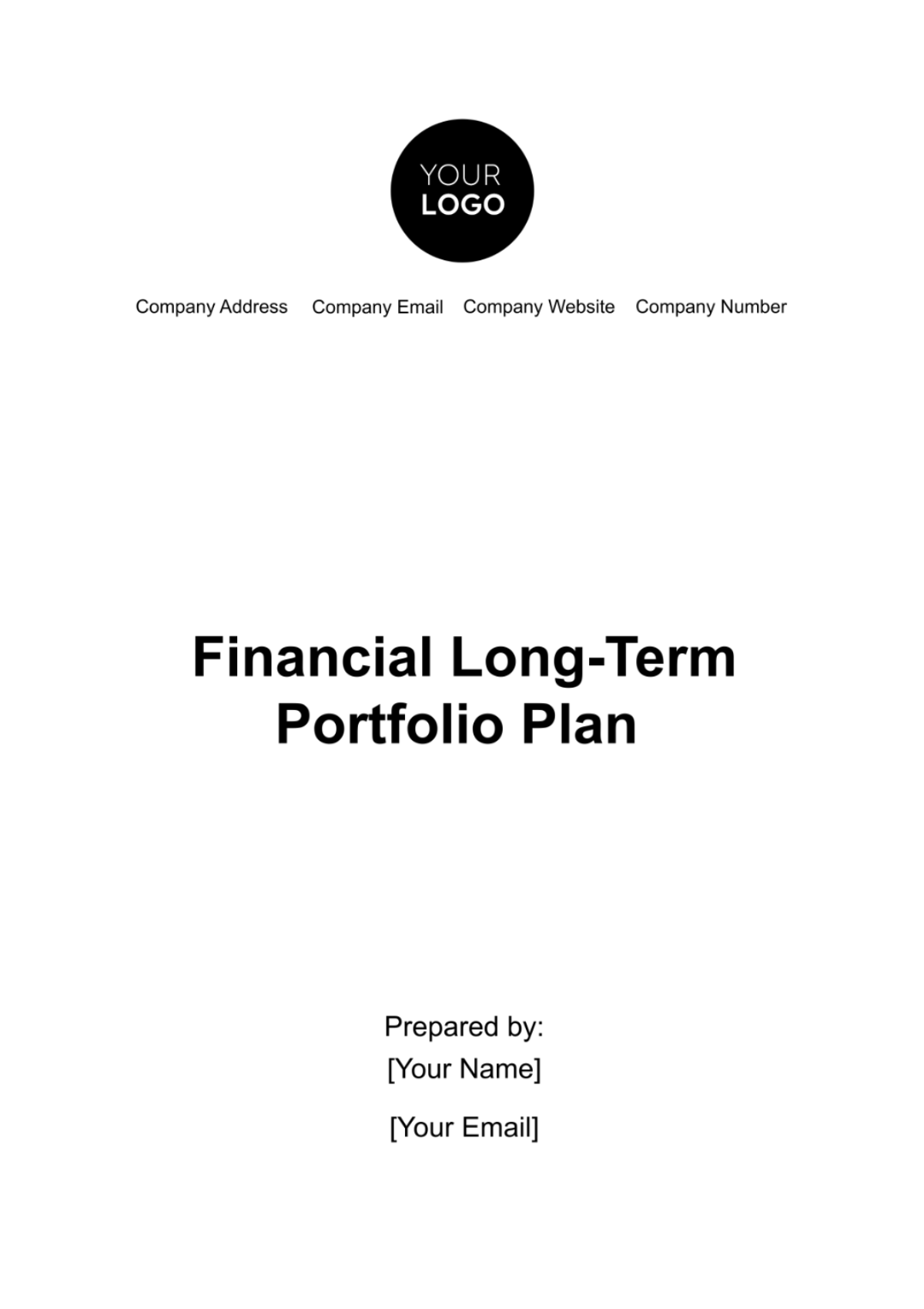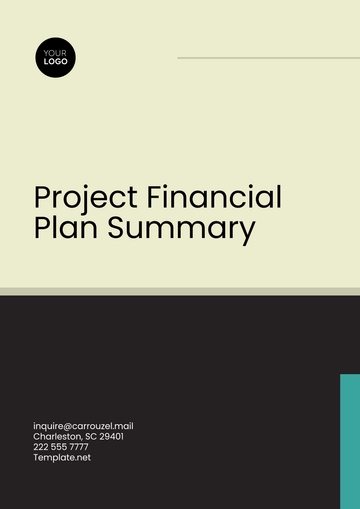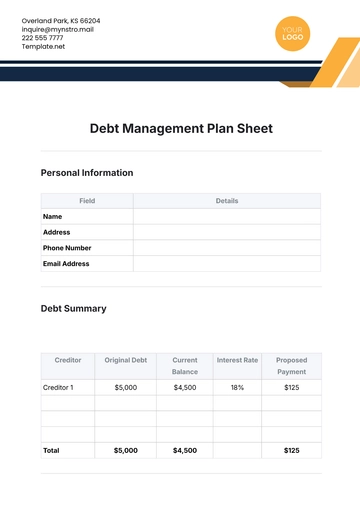Free Financial Long-Term Portfolio Plan

Executive Summary
This Financial Long-Term Portfolio Plan for [Your Company Name] outlines a comprehensive strategy designed to achieve sustained financial growth and stability over the next decade. Recognizing the dynamic nature of global markets, we have developed a diversified approach that balances risk and reward, aligns with our corporate objectives, and adheres to our commitment to responsible investing. This plan is a living document, subject to periodic reviews and adjustments in response to evolving market conditions and company goals.
Company Overview
Founded in [Year], [Your Company Name] has established itself as a leader in [Industry Sector], with a robust portfolio of products and services that cater to a diverse clientele. Headquartered in [City, State], we have expanded our operations across [Number] countries, capitalizing on emerging market opportunities while consolidating our presence in established markets. Our success is anchored on a culture of innovation, customer-centricity, and stringent corporate governance. Looking ahead, we aim to leverage our strengths to tap into new growth avenues while maintaining a strong financial foundation.
Investment Philosophy
Our investment philosophy is rooted in a strategic mix of growth, value, and sustainability. We prioritize investments that offer long-term growth potential, underpinned by strong fundamentals and a clear competitive advantage. Value investing is key – we seek undervalued assets with potential for appreciation. Sustainability is a cross-cutting theme, as we
commit to environmentally and socially responsible investments. We believe this balanced approach will drive superior returns while mitigating risks, ensuring our portfolio remains resilient in varying market conditions.
Market Analysis
Global Economic Trends:
The global economy is showing signs of gradual recovery post-pandemic, with an average GDP growth rate projected at 3.5% over the next five years. However, geopolitical tensions and trade uncertainties pose risks.
Emerging markets, particularly in Asia and Africa, are expected to outpace developed economies, offering lucrative investment opportunities.
Technological advancements, especially in AI, IoT, and renewable energy, are reshaping industries, signaling a shift towards tech-driven investments.
Industry Insights:
The [Your Industry] sector is forecasted to grow at 6% annually, driven by increasing demand in [Specific Areas].
Regulatory changes and increased digital adoption are key trends shaping the industry landscape.
Competitive dynamics show a trend towards consolidation, with larger players acquiring niche companies to broaden their market reach and capabilities.
Asset Allocation Strategy
Equities (40% of Portfolio):
Focus on blue-chip and mid-cap companies in technology, healthcare, and renewable energy sectors.
Geographic diversification with 50% in North American markets, 30% in emerging Asian markets, and 20% in Europe.
Fixed Income (30% of Portfolio):
Emphasis on government bonds and high-grade corporate debt, aiming for stability and predictable returns.
Duration mix: 40% in short-term securities (1-3 years), 40% in medium-term (4-7 years), and 20% in long-term bonds (8+ years).
Real Estate (15% of Portfolio):
Commercial real estate in urban centers with strong growth potential.
Residential projects in emerging markets with a focus on affordable housing.
Alternative Investments (15% of Portfolio):
Private equity in startups and SMEs in tech and green energy sectors.
Hedge funds with a track record of outperforming the market in volatile conditions.
Risk Management
Quantitative Analysis
Quantitative analysis in risk management involves using statistical and mathematical models to predict and understand the behavior of the investment portfolio under various market conditions. Regular stress testing is a key component here. This means simulating different financial scenarios (like market crashes, interest rate changes, and inflation spikes) to see how the portfolio might perform. The goal is to identify potential vulnerabilities and adjust the strategy accordingly to mitigate these risks.
Qualitative Assessment
This aspect involves regularly reviewing non-quantifiable factors that could impact investments. Political changes, such as new legislation or shifts in government policies, can significantly affect market conditions and investment climates. Economic shifts like changes in GDP growth, unemployment rates, or consumer spending habits also play a crucial role. Additionally, keeping abreast of regulatory changes ensures that the investment strategies comply with current laws and guidelines, avoiding potential legal issues.
Risk Diversification
Diversification is a strategy used to reduce risk by allocating investments among various financial instruments, industries, and other categories. It aims to maximize returns by investing in different areas that would each react differently to the same event. For example, when one market or asset class is performing poorly, another might be doing well, thereby balancing the overall risk in the portfolio.
Hedging Strategies
Hedging involves using financial instruments (like options, futures, and swaps) to offset potential losses in an investment. For instance, if a portfolio has a significant position in a particular stock, a hedge might involve purchasing a put option on that stock, which increases in value as the stock's price falls, thus mitigating some of the loss.
Compliance and Ethics
Maintaining high standards of compliance and ethics is vital for risk management. This involves adhering to legal standards, conducting regular audits, and ensuring investments are made in an ethical and socially responsible manner. Anti-money laundering regulations and other financial compliance standards must be strictly followed to prevent legal repercussions and maintain corporate integrity.
Portfolio Diversification
By Asset Class
Allocating investments across different asset classes (equities, fixed income, real estate, and alternative investments) helps in balancing the risk and return profile of the portfolio. Each asset class has different characteristics and responds differently to market conditions.
Geographical Diversification
Investing in different geographical regions can help mitigate the risk associated with any single country or region. This approach takes advantage of growth in different economies and buffers against region-specific downturns and volatility.
Sectoral Spread
Investing across a range of sectors (like technology, healthcare, and renewable energy) ensures that the portfolio is not overly dependent on the performance of a single industry. This is crucial for long-term growth as it captures
the potential of diverse sectors, each with its own growth trajectory and risk profile.
Investment Selection
Equities
Selecting stocks involves analyzing company fundamentals like financial health, earnings potential, and management quality. Technical analysis, which examines market trends and price movements, also informs stock selection. This dual approach helps in picking stocks that are not only fundamentally strong but also well-positioned in the market.
Bonds
In bond investments, focus is placed on credit quality (assessing the issuer's ability to repay), yield (the return expected on the bond), and the bond's maturity profile. Preference is usually given to issuers with high credit ratings indicating lower default risk. The maturity profile of bonds is chosen based on interest rate expectations and cash flow needs.
Real Estate
Real estate investments are selected based on location, market demand, and growth potential. This includes assessing factors like demographic trends, economic growth in the area, and property market dynamics. The aim is to identify properties that offer both rental income and capital appreciation.
Alternative Investments
Alternative investments like private equity and hedge funds require rigorous due diligence. This involves evaluating the track record of the management team, the viability of the business model, and the market potential of the investment. Due to their complexity and unique risks, these investments often require specialized expertise.
Performance Monitoring and Rebalancing
Regular Reviews
Quarterly performance reviews ensure that the portfolio is on track to meet its strategic objectives. These reviews compare actual performance against benchmarks and goals, allowing for timely adjustments.
Rebalancing
Portfolio composition can drift over time due to differing returns from various assets. Rebalancing involves adjusting the weightings of assets in the portfolio to maintain the desired risk-return profile. This could mean selling assets that have grown beyond their target allocation and buying more of those that have underperformed.
Performance Metrics
Key metrics like return on investment (ROI), alpha (performance relative to a benchmark), and beta (measure of volatility relative to the market) are tracked. Additionally, qualitative factors such as management effectiveness and market position of the invested companies are considered.
Tax Considerations
Proactive tax planning is crucial to minimize tax liabilities and enhance overall returns. This involves strategies like tax-loss harvesting, choosing tax-efficient investment vehicles, and timing the realization of capital gains and losses.
Utilizing tax-advantaged accounts and investments can significantly impact after-tax returns. This might include investing in retirement accounts like IRAs or 401(k)s, which offer tax benefits.
Regular consultations with tax experts help stay updated with tax law changes, ensuring the investment strategy remains tax-efficient and compliant.
Retirement and Estate Planning
Retirement Planning
Aligning investments with the retirement objectives of executives and employees involves offering a range of retirement plan options, each suited to different investment styles and risk tolerances. This helps employees in building their retirement savings in a manner that aligns with their personal financial goals.
Estate Planning
Estate planning ensures that wealth is preserved and smoothly transferred to beneficiaries. This involves structuring investments in ways that are advantageous for estate taxes and planning for the orderly transfer of assets. Working with legal advisors, the company can implement strategies like setting up trusts or designating beneficiaries, which can minimize estate taxes and ensure that assets are distributed according to the investor's wishes.
Incorporating estate planning into investment decisions is not only about preserving wealth but also about ensuring that the investor's legacy is carried on in the manner they intend. This requires a deep understanding of the legal implications of various investment vehicles and the tax consequences of different estate planning strategies.
Succession Planning
Ensuring the portfolio supports long-term succession plans, particularly in maintaining company stability and financial security during leadership transitions.
Developing strategies for seamless transition of investment oversight to future company leaders or designated managers. This includes training and knowledge transfer sessions to ensure continuity in investment philosophy and tactics.
- 100% Customizable, free editor
- Access 1 Million+ Templates, photo’s & graphics
- Download or share as a template
- Click and replace photos, graphics, text, backgrounds
- Resize, crop, AI write & more
- Access advanced editor
Introduce strategic planning to your financial goals with the Financial Long-Term Portfolio Plan Template from Template.net. This professional template is fully editable and customizable with our AI Editor Tool, designed to guide users in creating robust, long-term investment strategies. It offers a structured approach for balanced portfolio development, ensuring thorough planning and execution for enduring financial health and growth.
You may also like
- Finance Plan
- Construction Plan
- Sales Plan
- Development Plan
- Career Plan
- Budget Plan
- HR Plan
- Education Plan
- Transition Plan
- Work Plan
- Training Plan
- Communication Plan
- Operation Plan
- Health And Safety Plan
- Strategy Plan
- Professional Development Plan
- Advertising Plan
- Risk Management Plan
- Restaurant Plan
- School Plan
- Nursing Home Patient Care Plan
- Nursing Care Plan
- Plan Event
- Startup Plan
- Social Media Plan
- Staffing Plan
- Annual Plan
- Content Plan
- Payment Plan
- Implementation Plan
- Hotel Plan
- Workout Plan
- Accounting Plan
- Campaign Plan
- Essay Plan
- 30 60 90 Day Plan
- Research Plan
- Recruitment Plan
- 90 Day Plan
- Quarterly Plan
- Emergency Plan
- 5 Year Plan
- Gym Plan
- Personal Plan
- IT and Software Plan
- Treatment Plan
- Real Estate Plan
- Law Firm Plan
- Healthcare Plan
- Improvement Plan
- Media Plan
- 5 Year Business Plan
- Learning Plan
- Marketing Campaign Plan
- Travel Agency Plan
- Cleaning Services Plan
- Interior Design Plan
- Performance Plan
- PR Plan
- Birth Plan
- Life Plan
- SEO Plan
- Disaster Recovery Plan
- Continuity Plan
- Launch Plan
- Legal Plan
- Behavior Plan
- Performance Improvement Plan
- Salon Plan
- Security Plan
- Security Management Plan
- Employee Development Plan
- Quality Plan
- Service Improvement Plan
- Growth Plan
- Incident Response Plan
- Basketball Plan
- Emergency Action Plan
- Product Launch Plan
- Spa Plan
- Employee Training Plan
- Data Analysis Plan
- Employee Action Plan
- Territory Plan
- Audit Plan
- Classroom Plan
- Activity Plan
- Parenting Plan
- Care Plan
- Project Execution Plan
- Exercise Plan
- Internship Plan
- Software Development Plan
- Continuous Improvement Plan
- Leave Plan
- 90 Day Sales Plan
- Advertising Agency Plan
- Employee Transition Plan
- Smart Action Plan
- Workplace Safety Plan
- Behavior Change Plan
- Contingency Plan
- Continuity of Operations Plan
- Health Plan
- Quality Control Plan
- Self Plan
- Sports Development Plan
- Change Management Plan
- Ecommerce Plan
- Personal Financial Plan
- Process Improvement Plan
- 30-60-90 Day Sales Plan
- Crisis Management Plan
- Engagement Plan
- Execution Plan
- Pandemic Plan
- Quality Assurance Plan
- Service Continuity Plan
- Agile Project Plan
- Fundraising Plan
- Job Transition Plan
- Asset Maintenance Plan
- Maintenance Plan
- Software Test Plan
- Staff Training and Development Plan
- 3 Year Plan
- Brand Activation Plan
- Release Plan
- Resource Plan
- Risk Mitigation Plan
- Teacher Plan
- 30 60 90 Day Plan for New Manager
- Food Safety Plan
- Food Truck Plan
- Hiring Plan
- Quality Management Plan
- Wellness Plan
- Behavior Intervention Plan
- Bonus Plan
- Investment Plan
- Maternity Leave Plan
- Pandemic Response Plan
- Succession Planning
- Coaching Plan
- Configuration Management Plan
- Remote Work Plan
- Self Care Plan
- Teaching Plan
- 100-Day Plan
- HACCP Plan
- Student Plan
- Sustainability Plan
- 30 60 90 Day Plan for Interview
- Access Plan
- Site Specific Safety Plan





























